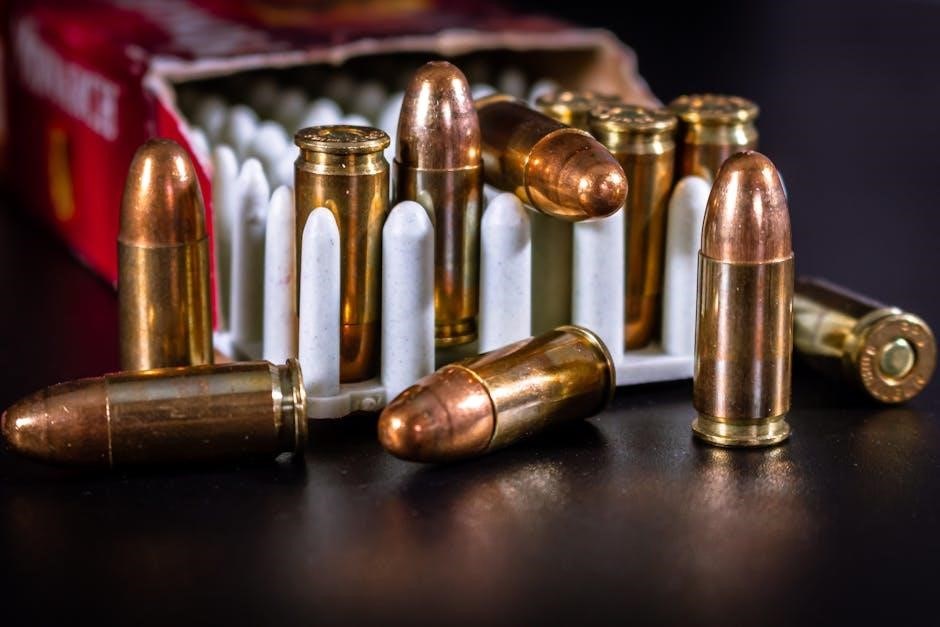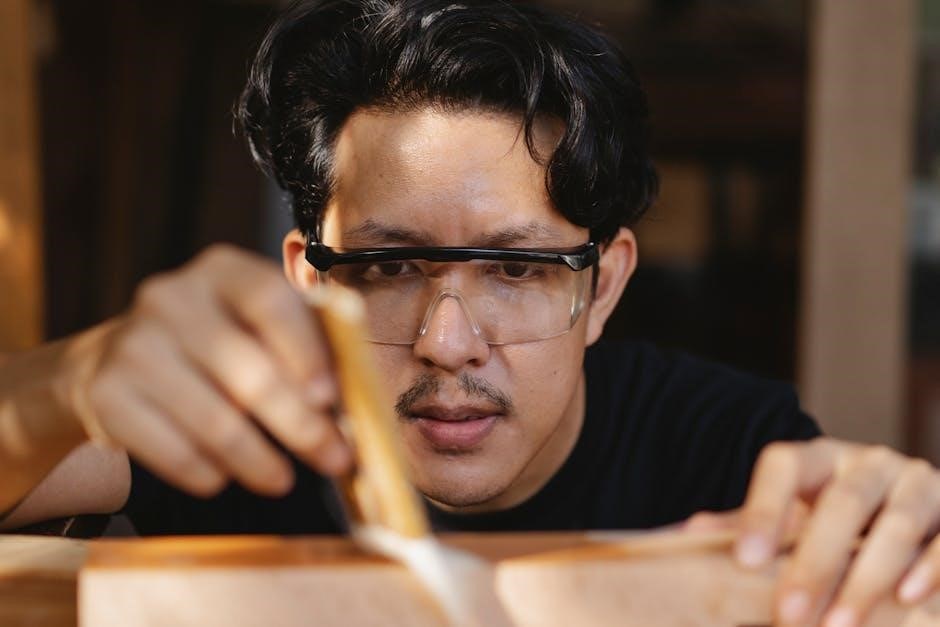Overview of 9mm Pistols
9mm pistols with manual safety are popular for their reliability and ergonomic design‚ offering a mechanical layer of protection against accidental discharges while maintaining quick access for defensive situations.
9mm pistols are among the most widely used handguns globally‚ favored for their balance of power‚ recoil‚ and magazine capacity. Available in full-size‚ compact‚ and subcompact designs‚ they cater to various needs‚ from law enforcement to concealed carry. The 9mm calibre offers manageable recoil‚ making it accessible to a broad range of shooters. Pistols with manual safety mechanisms provide an additional layer of control‚ appealing to users who prioritize an extra level of security. These firearms are renowned for their reliability‚ durability‚ and versatility‚ making them a popular choice for both professionals and civilian shooters. Their widespread adoption underscores their effectiveness in self-defense and tactical scenarios.
Importance of Manual Safety in Pistols
The manual safety mechanism in pistols serves as a critical feature designed to prevent accidental discharges‚ providing an additional layer of control for the user. By engaging the safety‚ the firearm is rendered inoperable‚ reducing the risk of unintended firing‚ especially during holstering or carrying. This feature is particularly valued in high-stress situations‚ where the ability to deliberately disengage the safety can enhance intentional actions. Many shooters and carriers prefer manual safeties for the peace of mind they offer‚ knowing they have a mechanical safeguard against mishaps. However‚ it’s crucial for users to receive proper training to ensure smooth operation under pressure‚ as relying solely on the safety can lead to delays in critical moments.
Historical Development of Manual Safety Features
The development of manual safety mechanisms in pistols dates back to the early 20th century‚ with the M1911 being one of the first widely adopted designs featuring a thumb-operated safety. This innovation was driven by the need for user control and accident prevention‚ particularly in military and law enforcement contexts. Over time‚ manufacturers refined these mechanisms‚ incorporating them into various pistol designs like the Walther P38 and Beretta 92. The manual safety became a standard feature in many 9mm pistols‚ offering a reliable way to prevent unintended discharges. Its evolution reflects advancements in firearm safety technology‚ balancing functionality with practicality for both professional and civilian use.

Design and Functionality
9mm pistols with manual safety integrate sleek designs with functionality‚ balancing ergonomics and safety. The manual safety mechanism provides an additional layer of control‚ ensuring intentional engagement while maintaining rapid deployment capabilities.
Key Components of a Manual Safety Mechanism
A manual safety mechanism in 9mm pistols typically includes a thumb-operated lever‚ a sear engagement system‚ and a detent to secure the lever in the “safe” or “fire” position. The lever is strategically placed for easy access‚ often on the frame‚ allowing the user to disengage it with a deliberate motion. The sear engagement system prevents the trigger from moving rearward unless the safety is off‚ ensuring the pistol cannot fire accidentally. Some models feature additional components like trigger blocks or internal safeties for enhanced security. These components work in harmony to provide a reliable and intuitive safety system‚ catering to both concealed carry and home defense scenarios.
How Manual Safety Differs from Other Safety Mechanisms
A manual safety mechanism differs from other safety systems by requiring deliberate user interaction to engage or disengage. Unlike trigger safeties‚ which automatically deactivate when the trigger is pressed properly‚ manual safeties provide an additional physical layer of control. Internal safeties‚ such as drop safeties or firing pin blocks‚ operate passively without user input. Manual safeties are unique in offering a tactile confirmation of the pistol’s readiness‚ appealing to users who prefer an extra level of intentional control. This deliberate action contrasts with striker-fired pistols that rely solely on trigger pressure for safety. The manual safety’s design emphasizes user agency‚ making it a distinct choice for those prioritizing mechanical security.
Pros and Cons of Manual Safety in 9mm Pistols
Manual safety in 9mm pistols offers enhanced control and security‚ providing a visible and tactile confirmation of the firearm’s status. This feature can prevent accidental discharges‚ especially during holstering or handling. However‚ it requires deliberate action to disengage‚ which may delay response times in high-stress situations. Users must train consistently to ensure smooth operation. While some appreciate the added layer of safety‚ others argue it introduces complexity and potential points of failure. The manual safety’s appeal often hinges on personal preference‚ training discipline‚ and intended use‚ making it a debated yet viable option for both concealed carry and home defense scenarios.
Popular Models of 9mm Pistols with Manual Safety
Notable 9mm pistols with manual safety include the SIG Sauer M17 and M18‚ Beretta Px4 Storm‚ and Mossberg MC2C‚ each offering reliable performance and safety features.
Full-Size Pistols with Manual Safety
Full-size 9mm pistols with manual safety are favored for their balance of power and control. Models like the SIG Sauer M17 and M18‚ designed for military and law enforcement‚ feature a thumb-operated manual safety that enhances security without compromising accessibility. The Beretta Px4 Storm stands out with its reversible manual safety‚ catering to both left- and right-handed shooters. These pistols often include ergonomic designs‚ such as checkered grips and ambidextrous controls‚ ensuring comfort and intuitive operation. Full-size models typically have longer barrels‚ improving accuracy‚ and higher magazine capacities‚ making them ideal for home defense or duty use. Their robust construction and reliability under stress further solidify their reputation as dependable sidearms.
Compact and Subcompact Pistols with Manual Safety
Compact and subcompact 9mm pistols with manual safety are designed for concealed carry‚ offering a balance between portability and functionality. The SIG Sauer P238‚ for instance‚ features a thumb safety reminiscent of the 1911 design‚ providing a familiar control for experienced shooters. Similarly‚ the Smith & Wesson M&P9 Shield EZ incorporates a manual safety option‚ combining ease of use with enhanced security. These pistols are engineered with slim profiles and lightweight materials‚ making them ideal for everyday carry without compromising on safety features. Their smaller frames are complemented by ergonomic grips‚ ensuring a secure hold even in high-stress situations. This blend of compact design and manual safety makes them a popular choice for self-defense and concealed carry enthusiasts.
Specialized Pistols with Manual Safety for Specific Uses
Specialized 9mm pistols with manual safety are tailored for unique applications‚ such as competition shooting or tactical operations. The Beretta Px4 Storm Type F‚ for example‚ features a manual safety designed for precision and control‚ making it ideal for competitive shooters. Similarly‚ the Mossberg MC2c offers a cross-bolt safety‚ catering to users who prioritize intuitive operation. These pistols often incorporate ergonomic designs and customizable features‚ ensuring they meet the demands of specific uses while maintaining the added security of a manual safety mechanism. Their versatility and adaptability make them favored choices for professionals and enthusiasts seeking reliability in specialized scenarios.

Manual Safety in Concealed Carry and Self-Defense
Manual safety in concealed carry adds an extra layer of security‚ particularly in high-stress situations‚ while models like the Sig P320 M18 and Beretta Px4 Storm emphasize quick access and reliability.
Role of Manual Safety in Concealed Carry
Manual safety in concealed carry serves as an additional layer of protection against accidental discharges‚ offering peace of mind for carriers. For many‚ it provides a tactile confirmation that the firearm is secured‚ reducing the risk of unintended activation during holstering or daily activities. Pistols like the Sig P320 M18 and Beretta Px4 Storm‚ equipped with manual safeties‚ are popular choices for concealed carry due to their balance of safety and quick accessibility. While some argue that manual safeties can complicate draw procedures‚ proper training ensures seamless engagement and disengagement‚ making them a reliable option for self-defense scenarios. The manual safety reinforces responsible carry practices‚ emphasizing situational awareness and intentional weapon deployment.
Manual Safety Considerations for Self-Defense Scenarios
In high-stress self-defense situations‚ the manual safety can provide an added layer of control‚ ensuring the firearm does not discharge unintentionally. However‚ its effectiveness hinges on proper training and muscle memory‚ as fumbling with the safety during an emergency can delay response times. Advocates emphasize the importance of consistent practice in safely engaging and disengaging the mechanism‚ ensuring it becomes second nature. Conversely‚ critics argue that manual safeties can introduce an extra step‚ potentially complicating quick access during life-threatening encounters. Ultimately‚ the decision to rely on a manual safety in self-defense requires careful consideration of personal proficiency and situational awareness‚ balancing the benefits of added security with the need for rapid deployment.
Best Practices for Using Manual Safety in High-Stress Situations
Mastering the manual safety in high-stress scenarios requires consistent training and muscle memory. Always practice drawing and holstering with the safety engaged to build second-nature habits. Ensure situational awareness‚ keeping fingers away from the trigger until ready to fire. Train to disengage the safety smoothly during the draw stroke‚ minimizing delays. Regular drills‚ such as rapid engagement and disengagement exercises‚ enhance proficiency. Consider using holsters designed to accommodate the safety lever to prevent accidental interference. Stay calm and focused‚ as panic can lead to fumbling with the mechanism. Proficiency with the manual safety ensures both safety and reliability in critical moments‚ making it a valuable skill for self-defense scenarios.

Training and Handling
Proper training and handling of 9mm pistols with manual safety are essential for safe and effective use. Consistent practice builds muscle memory for engaging and disengaging the safety‚ ensuring quick access in high-stress situations while maintaining control and preventing accidental discharges. Regular drills‚ such as drawing and holstering‚ help refine technique and confidence. Safe handling practices‚ including keeping fingers away from the trigger until ready to fire‚ are critical for responsible ownership and operation.
Proper Techniques for Engaging and Disengaging the Safety
Engaging and disengaging the manual safety on a 9mm pistol requires deliberate practice to ensure smooth‚ intuitive operation. When engaging the safety‚ use your thumb to move the lever to the “on” position‚ ensuring it clicks firmly into place. This action should be performed deliberately to avoid accidental activation. For disengaging‚ use the same thumb to sweep the lever downward or sideways‚ depending on the pistol’s design‚ in a smooth‚ consistent motion. Regular training helps build muscle memory‚ allowing these actions to become second nature‚ even in high-stress situations. Always perform a safety check after disengaging to confirm the pistol is ready to fire. Avoid using other fingers‚ as this can disrupt grip control and lead to unintended consequences.
Training Drills to Master Manual Safety Usage
Mastering manual safety usage requires consistent practice through targeted drills. Start with dry-fire exercises‚ focusing on smoothly engaging and disengaging the safety without disrupting your grip. Next‚ incorporate safety manipulation into draw strokes‚ practicing drawing the pistol and disengaging the safety in one fluid motion. Timed drills‚ such as engaging or disengaging the safety within a set time‚ improve speed and accuracy. Additionally‚ practice safety operations in various shooting positions and under simulated stress conditions to build muscle memory and adaptability. These drills ensure that manual safety usage becomes second nature‚ enhancing both safety and efficiency in real-world scenarios.
Common Mistakes to Avoid When Using Manual Safety
One of the most common mistakes is forgetting to disengage the safety during high-stress situations‚ which can delay response times. Another error is improperly holstering the pistol with the safety off‚ increasing the risk of accidental discharge. Some users also rely solely on the manual safety without following proper handling practices‚ such as keeping their finger off the trigger. Additionally‚ neglecting to practice consistent safety engagement and disengagement can lead to fumbling during critical moments. These mistakes highlight the importance of rigorous training and adherence to safe handling protocols to ensure the manual safety functions as intended and enhances overall firearm safety.
Safety and Responsibility
Safety and responsibility are paramount when handling 9mm pistols with manual safety. Proper training‚ awareness‚ and adherence to safe handling practices are essential to prevent accidents and ensure responsible firearm ownership.
Safe Handling Practices for Pistols with Manual Safety
Safe handling of 9mm pistols with manual safety requires consistent training and adherence to best practices. Always ensure the manual safety is engaged when the pistol is not in use‚ and keep your finger off the trigger until ready to fire. Regularly inspect the safety mechanism to ensure proper function. Store the pistol in a secure holster or safe‚ unloaded or with the safety on‚ to prevent accidental discharges; Practice drawing and reholstering with the safety engaged to build muscle memory. Additionally‚ stay aware of your surroundings and avoid complacency‚ especially in high-stress situations. Proper maintenance and understanding of the safety mechanism are crucial for responsible ownership and use.
Statistics on Accidental Discharges and Manual Safety
Studies indicate that manual safety mechanisms significantly reduce accidental discharges in 9mm pistols. Data shows that firearms equipped with manual safeties are involved in fewer unintended firing incidents compared to those without. According to recent statistics‚ pistols with manual safeties account for less than 5% of reported accidental discharges‚ highlighting their effectiveness in preventing such events. These statistics emphasize the importance of manual safety features in enhancing firearm safety‚ particularly in self-defense and concealed carry scenarios where unintended discharges could have severe consequences. The inclusion of manual safeties is thus a critical factor in minimizing risks associated with handgun ownership and use.
Legal Implications of Carrying a Pistol with Manual SafetyThe legal implications of carrying a 9mm pistol with manual safety vary by jurisdiction. In some states‚ the presence of a manual safety may influence perceptions of intent or negligence in legal proceedings. Proper licensing‚ permits‚ and adherence to concealed carry laws are essential to avoid legal consequences. Additionally‚ some jurisdictions may require specific safety features‚ including manual safeties‚ to be legally compliant for concealed carry. It is crucial for carriers to understand local laws and ensure their firearm meets all legal requirements. Failure to comply can result in criminal charges‚ regardless of the pistol’s safety features. Legal considerations underscore the importance of responsible firearm ownership and carry practices.
The Great Debate: Manual Safety vs. No Manual Safety
The debate centers on whether manual safeties enhance security or hinder quick access in emergencies‚ with advocates emphasizing added safety and opponents prioritizing unobstructed functionality.
Arguments in Favor of Manual Safety
Proponents of manual safety argue that it provides an additional layer of security‚ preventing accidental discharges‚ especially during holstering or handling; This feature is particularly valued by new shooters‚ as it offers a clear‚ tactile confirmation that the firearm is ready to use. Manual safety mechanisms can also serve as a training tool‚ reinforcing safe handling practices and the importance of deliberate actions. In high-stress situations‚ some users find comfort in the physical reassurance that the safety provides‚ allowing for controlled engagement. Critics of no-manual-safety pistols often highlight the potential for unintended discharges‚ making the manual safety a preferred choice for those prioritizing added control and peace of mind.
Arguments Against Manual Safety
Oponents argue that manual safety mechanisms can hinder quick access in life-threatening situations‚ potentially delaying response times. Many modern pistols with striker-fired designs are engineered without manual safeties‚ relying instead on trigger safeties and ergonomic designs to prevent accidental discharges. Critics suggest that manual safeties add unnecessary complexity‚ requiring additional training and muscle memory to engage or disengage under stress. Additionally‚ some users find manual safeties cumbersome‚ particularly during rapid firing or when wearing gloves. This has led to a shift toward pistols without manual safeties‚ emphasizing reliability and simplicity in self-defense scenarios.
Expert Opinions on the Usefulness of Manual Safety
Experts are divided on the usefulness of manual safety mechanisms in 9mm pistols. Some law enforcement trainers emphasize the importance of manual safeties as an additional layer of control‚ particularly in high-stress situations where accidental discharges could occur. They argue that a manual safety provides a tactile confirmation of the pistol’s readiness‚ enhancing situational awareness. On the other hand‚ competitive shooters and concealed carry instructors often prefer pistols without manual safeties‚ citing faster deployment and reduced complexity. They argue that modern trigger systems are sufficiently safe without the need for manual intervention. Ultimately‚ the decision to use a manual safety hinges on personal preference‚ training‚ and the specific context of use.

Accessories and Enhancements
Holsters designed for pistols with manual safety ensure secure carry‚ while light and laser accessories enhance visibility and accuracy. Aftermarket modifications can further customize the safety mechanism for optimal performance.
Holsters Designed for Pistols with Manual Safety
Holsters for 9mm pistols with manual safety are crafted to accommodate the safety lever‚ ensuring secure carry and easy access. Materials like Kydex and leather are popular for durability and comfort. Inside-the-waistband (IWB) and outside-the-waistband (OWB) options are available‚ catering to concealed and open carry preferences. These holsters often feature retention systems to prevent accidental discharges while allowing quick drawing. Some designs include thumb breaks or reinforced areas to protect the safety mechanism. Popular brands like Galco and Safariland offer tailored fits for specific models. Custom holsters can also be modified to suit individual preferences‚ ensuring a perfect blend of functionality and personal style. Always choose a holster that complements your pistol’s safety features for optimal carry.
Light and Laser Accessories for Enhanced Safety
Light and laser accessories are popular additions to 9mm pistols with manual safety‚ enhancing low-light targeting and situational awareness. These accessories‚ such as laser sights or LED flashlights‚ can be mounted on the pistol’s rail system‚ providing quick aiming and illumination. Lasers project a red or green dot onto the target‚ allowing for rapid alignment‚ while lights illuminate dark environments. Many modern pistols with manual safety are designed to accommodate these upgrades‚ ensuring seamless integration. Combination units offer both light and laser functionality‚ maximizing versatility. These tools enhance safety by improving accuracy and visibility‚ especially in high-stress scenarios. Popular brands like Crimson Trace and Streamlight offer reliable options tailored for pistols with manual safety‚ ensuring enhanced performance without compromising the safety mechanism. Proper training with these accessories is essential for effective use.
Aftermarket Modifications for Manual Safety Mechanisms
Aftermarket modifications for manual safety mechanisms in 9mm pistols offer customization to enhance functionality and user preference. Popular upgrades include extended safety levers‚ which provide a larger surface area for easier engagement and disengagement. Some manufacturers offer ambidextrous safeties for left-handed shooters or tactical users. Customizable safety textures and ergonomic designs can improve grip and accessibility. Additionally‚ adjustable safeties allow users to fine-tune the leverage for smoother operation. These modifications are often available from reputable brands like Wilson Combat or Apex Tactical. While they enhance performance‚ it’s crucial to ensure modifications don’t compromise the pistol’s reliability or safety. Always consider professional installation and warranty implications when upgrading the manual safety mechanism.
9mm pistols with manual safety remain relevant due to their proven reliability and versatility‚ with future trends focusing on ambidextrous designs‚ ergonomic enhancements‚ and advanced materials for improved functionality.
Evolution of Manual Safety in Modern Pistols
The manual safety mechanism in 9mm pistols has undergone significant evolution‚ adapting to modern shooter preferences and technological advancements. Historically‚ manual safeties were large and prominent‚ often designed for ease of access. Today‚ they are more streamlined and ergonomic‚ blending seamlessly into the pistol’s design. Many modern pistols feature ambidextrous safeties‚ catering to both left- and right-handed users. Additionally‚ some manufacturers have incorporated optional manual safeties‚ allowing shooters to choose between models with or without this feature. Despite the trend toward striker-fired pistols without manual safeties‚ the demand for manual safeties persists‚ particularly among those who value an extra layer of control. This evolution reflects a balance between tradition and innovation‚ ensuring manual safeties remain relevant in the market.
Future Developments in Pistol Safety Technology
Future advancements in pistol safety technology are expected to integrate smart systems‚ such as biometric triggers and electronic safeties‚ ensuring weapons fire only for authorized users. Modular designs may allow shooters to customize safety mechanisms‚ blending manual controls with modern innovations. Enhanced materials and ergonomic designs will improve functionality while maintaining safety. Additionally‚ advancements in training technology‚ like interactive simulators‚ will help shooters master manual safety usage. These innovations aim to balance safety‚ reliability‚ and usability‚ addressing evolving needs in self-defense‚ concealed carry‚ and law enforcement.
Final Thoughts on the Relevance of Manual Safety
Manual safety remains a divisive yet relevant feature in modern pistols‚ offering an additional layer of control for users prioritizing security. Its importance lies in providing a tangible barrier against accidental discharges‚ particularly for new shooters or those who prefer added safety. While some argue that modern safeties are redundant‚ others value the peace of mind it brings. As technology advances‚ the integration of manual safety into sleek‚ ergonomic designs ensures its continued appeal. Ultimately‚ the choice to use a manual safety reflects personal preference and shooting style‚ making it a timeless option in the ever-evolving world of firearms.